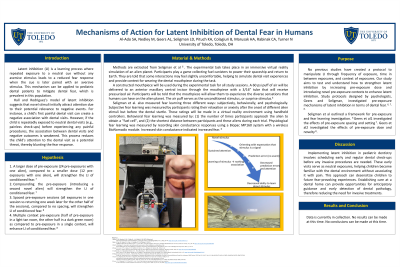Patient Management
243 - Mechanisms of Action for Latent Inhibition of Dental Fear in Humans

- SA
Sena Al-Ado, DDS
Pediatric Dental Resident
The University of Toledo Medical Center, Toledo, OH
University of Toledo
Sylvania, Ohio, United States - BC
Ben Colagiuri, PhD
University of Sydney
- AG
Andrew Geers, PhD
University of Toledo
- HM
Hilary Marusak, PhD
Wayne State University
- KP
Keenan Pituch, PhD
Arizona State University
- CR
Christine Rabinak, PhD
Wayne State University
- LS
Laura Seligman, PhD
University of Texas
- MN
Michael P. Nedley, DDS
Program Director
University of Toledo Medical Center
Toledo, Ohio, United States
Presenting Author(s)
Co-Author(s)
Program Director(s)
Purpose: Dental stimuli can trigger fear when associated with aversive outcomes like pain, but pre-exposing humans to potentially fear provoking stimuli before truly exposed to an aversive outcome can reduce dental fear learning through latent inhibition. This phenomenon occurs when prior exposure to a stimulus impairs its ability to form new associations during conditioning, potentially reducing the development of dental phobia. This study aims to determine how factors, such as pain sensitivity and pre exposure to stimulus, contribute to latent inhibition and fear learning.
Methods: In a virtual reality simulation, 180 participants, aged 6 to 35, were pre-exposed to conditioning trials, followed by short and long term learning tests. A brief puff of 60 psi pressurized air to a front tooth acted as the unconditioned stimulus. The study tested two factors: how the spacing of pre-exposure sessions (spaced vs. no spacing) and the type of pre-exposure (single vs. multiple contexts) influence latent inhibition. Pain sensitivity will also be assessed as a potential influence using self-reports and a cold pressor test.
Results: Data is still being collected and analyzed, therefore no conclusions can be drawn at this time. Expected results include: increasing pre exposure sessions and multiple contexts for pre exposure will improve latent inhibition, thereby decreasing dental fear.
Conclusions: Findings from this study could guide the development of prevention programs to reduce dental fear. By identifying ways to strengthen LI, this research aims to inform how dental fear can be prevented in practice.
Identify Supporting Agency and Grant Number: Research supported by National Institutes of Health (National Institute of Dental and Craniofacial Research) Type and Number: R01 (# R01DE031117)

.jpg)